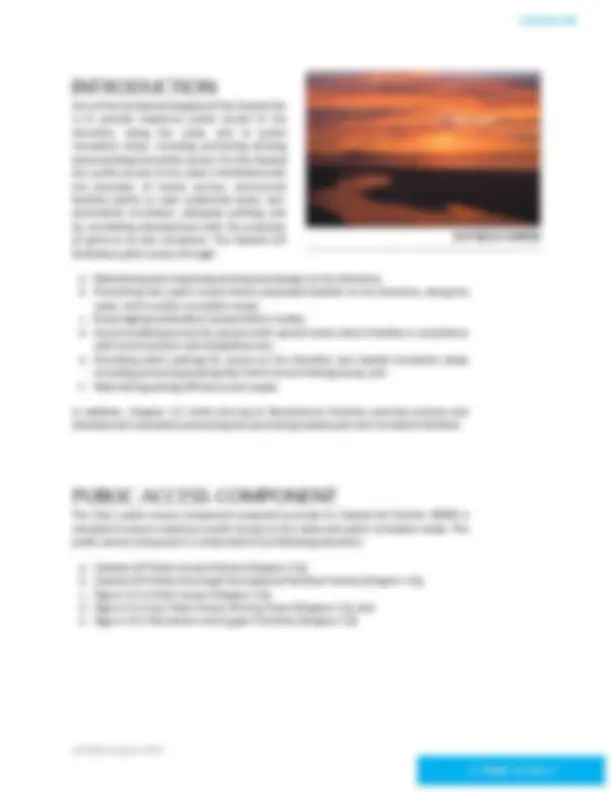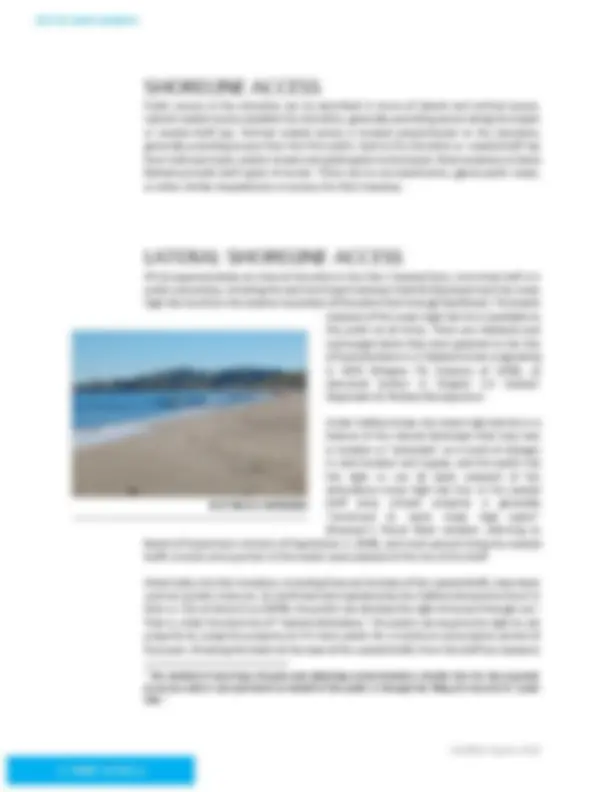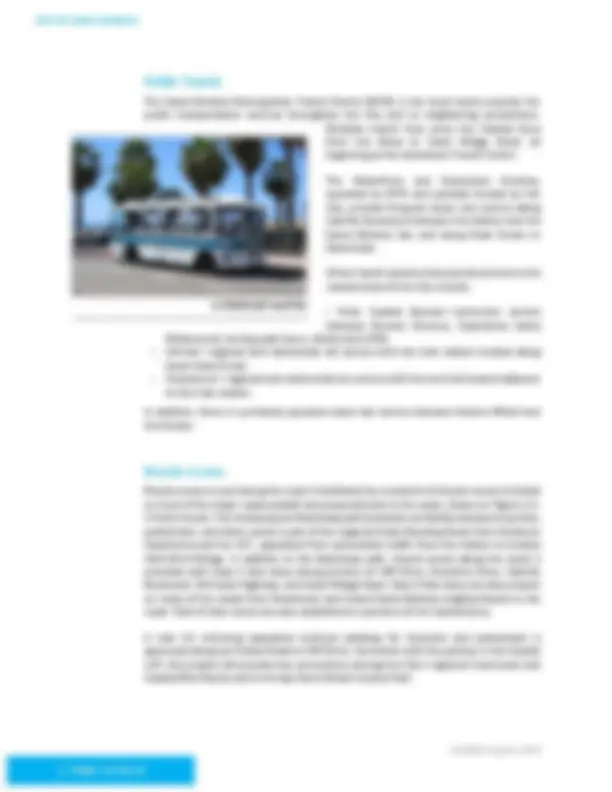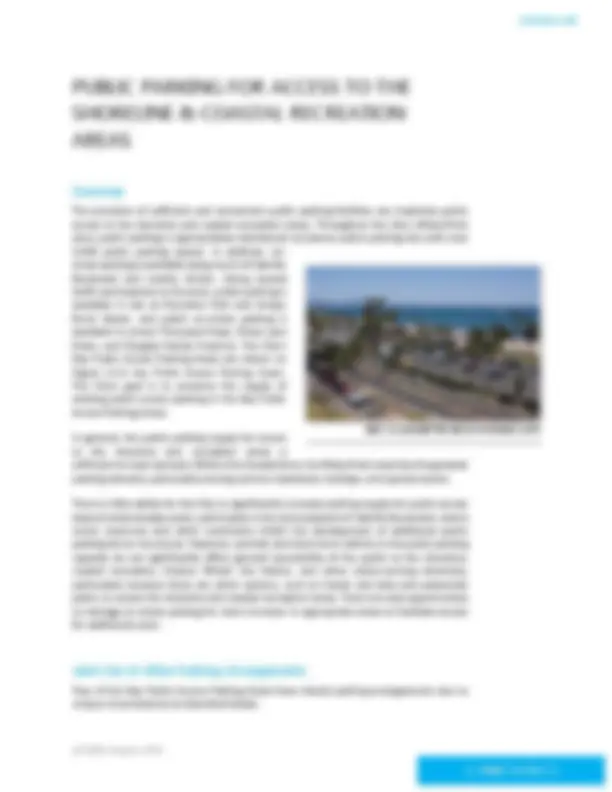
























Study with the several resources on Docsity

Earn points by helping other students or get them with a premium plan


Prepare for your exams
Study with the several resources on Docsity

Earn points to download
Earn points by helping other students or get them with a premium plan
Community
Ask the community for help and clear up your study doubts
Discover the best universities in your country according to Docsity users
Free resources
Download our free guides on studying techniques, anxiety management strategies, and thesis advice from Docsity tutors
The California Coastal Act's requirements for maximizing public access to the shoreline, coastal recreation areas, and public facilities. It includes provisions for new development projects, sustainable transportation, public parking, and coastal access signage. The document also discusses the City of Santa Barbara's public access component and efforts to reduce traffic and parking congestion at Santa Barbara City College.
Typology: Lecture notes
1 / 30

This page cannot be seen from the preview
Don't miss anything!























COASTAL LUP
Certified August, 2019
PHOTO: VIEW FROM BRAEMAR VISTA POINT
Coastal Act policies related to Public Access that are relevant to Santa Barbara include the following: Section 30210. In carrying out the requirement of Section 4 of Article X of the California Constitution, maximum access, which shall be conspicuously posted, and recreational opportunities shall be provided for all the people consistent with public safety needs and the need to protect public rights, rights of private property owners, and natural resource areas from overuse. Section 30211. Development shall not interfere with the public’s right of access to the sea where acquired through use or legislative authorization, including, but not limited to, the use of dry sand and rocky coastal beaches to the first line of terrestrial vegetation. Section 30212(a). Public access from the nearest public roadway to the shoreline and along the coast shall be provided in new development projects except where (1) it is inconsistent with public safety, military security needs, or the protection of fragile coastal resources, (2) adequate access exists nearby, or (3) agriculture would be adversely affected. Dedicated accessway shall not be required to be opened to public use until a public agency or private association agrees to accept responsibility for maintenance and liability of the accessway. Section 30212(c). Nothing in this division shall restrict public access nor shall it excuse the performance of duties and responsibilities of public agencies which are required by Sections 66478.1 to 66478.14, inclusive, of the Government Code and by Section 4 of Article X of the California Constitution. Section 30212.5. Wherever appropriate and feasible, public facilities, including parking areas or facilities, shall be distributed throughout an area so as to mitigate against the impacts, social and otherwise, of overcrowding or overuse by the public of any single area. Section 30214. (a) The public access policies of this article shall be implemented in a manner that takes into account the need to regulate the time, place, and manner of public access depending on the facts and circumstances in each case including, but not limited to, the following:
CITY OF SANTA BARBARA
Certified August, 2019
(1) Topographic and geologic site characteristics. (2) The capacity of the site to sustain use and at what level of intensity. (3) The appropriateness of limiting public access to the right to pass and repass depending on such factors as the fragility of the natural resources in the area and the proximity of the access area to adjacent residential uses. (4) The need to provide for the management of access areas so as to protect the privacy of adjacent property owners and to protect the aesthetic values of the area by providing for the collection of litter. (b) It is the intent of the Legislature that the public access policies of this article be carried out in a reasonable manner that considers the equities and that balances the rights of the individual property owner with the public’s constitutional right of access pursuant to Section 4 of Article X of the California Constitution. Nothing in this section or any amendment thereto shall be construed as a limitation on the rights guaranteed to the public under Section 4 of Article X of the California Constitution. (c) In carrying out the public access policies of this article, the commission and any other responsible public agency shall consider and encourage the utilization of innovative access management techniques, including, but not limited to, agreements with private organizations which would minimize management costs and encourage the use of volunteer programs. Section 30252. The location and amount of new development should maintain and enhance public access to the coast by (1) facilitating the provision or extension of transit service, (2) providing commercial facilities within or adjoining residential development or in other areas that will minimize the use of coastal access roads, (3) providing nonautomobile circulation within the development, (4) providing adequate parking facilities or providing substitute means of serving the development with public transportation, (5) assuring the potential for public transit for high intensity uses such as high-rise office buildings, and by (6) assuring that the recreational needs of new residents will not overload nearby coastal recreation areas by correlating the amount of development with local park acquisition and development plans with the provision of onsite recreational facilities to serve the new development. Section 30253. New development shall… minimize energy consumption and vehicle miles traveled. Article X, Section 4 of the California Constitution reads as follows: No individual, partnership, or corporation, claiming or possessing the frontage or tidal lands of a harbor, bay, inlet, estuary, or other navigable water in this State, shall be permitted to exclude the right of way to such water whenever it is required for any public purpose, nor to destroy or obstruct the free navigation of such water; and the Legislature shall enact such laws as will give the most liberal construction to this provision, so that access to the navigable waters of this State shall be always attainable for the people thereof. Section 30500(a). ...Each local coastal program prepared pursuant to this chapter shall contain a specific public access component to assure that maximum public access to the coast and public recreation areas is provided. Section 30604(c). Every coastal development permit issued for any development between the nearest public road and the sea or the shoreline of any body of water located within the coastal zone shall include a specific finding that the development is in conformity with the public access and public recreation policies of Chapter 3 (commencing with Section 30200).
CITY OF SANTA BARBARA
Certified August, 2019
Public access to the shoreline can be described in terms of lateral and vertical access. Lateral coastal access parallels the shoreline, generally providing access along the beach or coastal bluff top. Vertical coastal access is located perpendicular to the shoreline, generally providing access from the first public road to the shoreline or coastal bluff top from trails and stairs, and/or streets and parking lots to the beach. Most locations in Santa Barbara provide both types of access. There are no encroachments, gated public roads, or other similar impediments to access the City’s beaches.
Of the approximately six miles of shoreline in the City’s Coastal Zone, more than half is in public ownership, including the land and beach between Cabrillo Boulevard and the mean high tide line from the western boundary of Shoreline Park through East Beach. The beach seaward of the mean high tide line is available to the public at all times. There are tidelands and submerged lands that were granted to the City of Santa Barbara in a Tidelands Grant originating in 1925 (Chapter 78, Statutes of 1925), as discussed further in Chapter 2.2 Coastal- Dependent & Related Development.
Under California law, the mean high tide line is a feature of the natural landscape that may vary in location or “ambulate” as a result of changes in sand location and supply, and the public has the right to use all lands seaward of the ambulatory mean high tide line. In the coastal bluff area, private property is generally “construed to reach mean high water” (Assessor’s Parcel Book notation referring to Board of Supervisors minutes of September 2, 1930), and most parcels lining the coastal bluffs include some portion of the beach area seaward of the toe of the bluff.
Historically, the City’s beaches, including those at the base of the coastal bluffs, have been used as a public resource. As confirmed and explained by the California Supreme Court in Gion vs. City of Santa Cruz (1970), the public can develop the right of access through use.^1 That is, under the doctrine of “implied dedication,” the public can acquire the right to use property by using the property as if it were public for a minimum prescriptive period of five years. All along the beach at the base of the coastal bluffs, from the bluff toe seaward,
(^1) The method of resolving a dispute and obtaining a determination whether the City has acquired an access and/or use easement on behalf of the public is through the filing of a lawsuit to “quiet title.”
EAST BEACH SHORELINE
COASTAL LUP
Certified August, 2019
the consistent historic usage by the general public points clearly to the establishment of prescriptive rights. While high tides occasionally cover the entire beach to the base of the coastal bluffs, at low tides the receding ocean exposes areas of smooth-packed sand, ideal for walking. Since the early 1970s, City planning documents have included policies to protect the bluff-backed beaches as a community resource and prohibit any improvements that would change the nature of these tidal beaches.
The California Coastal Trail (CCT) is a network of interconnected public trails along the California coastline, designed to foster appreciation and stewardship of the scenic and natural resources of the coast and to implement aspects of Coastal Act policies promoting non-automobile circulation. The CCT system can be located on a variety of terrains, including the beach, coastal bluff near the edge and on hillsides that provide scenic vantage points, and within road rights-of-way. The types of paths within the system include unpaved footpaths, paved sidewalks, and separated bicycle paths.
Within the City limits, the CCT is continuous as lateral access along the beach. There is also a continuous inland alignment (shown on Figure 3.1-1 Public Access ) that is located on: the first public road paralleling the sea; the coastal bluffs where the property is in public ownership; and the shoreline on public sidewalks and bike paths. Segments of the trail are identified with a Coastal Conservancy CCT emblem incorporated onto City signs. The inland segments of the trail provide an alternative to beach access when high tides temporarily inundate the beach up to the base of the coastal bluffs. In Santa Barbara, the Juan Bautista de Anza National Historic Trail traverses roughly the same route as the CCT.
The approximately three miles of City-owned beach area from Shoreline Park to the coastal bluffs near the eastern City limits is a relatively wide sandy beach area with a high level of recreational use. This low-lying area provides direct access to the beach with no impediments. In the bluff areas, the portions of the steep coastal bluffs of up to 150 feet high that are lined with residential development present an impediment to direct beach access. However, there are several public parks along the bluffs and public vertical access ways to the beach from these steep coastal bluff areas that do provide direct beach access. The following are the public vertical access areas from west to east, also identified on Figure 3.1-1 Public Access :
COASTAL LUP
Certified August, 2019
The beaches below the coastal bluffs are already narrow and are routinely impassable during high tides. As this beach area narrows further due to increased erosion and permanent inundation from anticipated sea level rise, the location of stairways and trails from the coastal bluffs to the beach should be re-evaluated. For example, pocket beaches may form between headlands, and access to those areas could be considered if feasible.
The City’s vision for sustainable transportation notes that “while sustaining or increasing economic vitality and quality of life, Santa Barbara should be a city in which alternative forms of transportation and mobility are so available and so attractive that use of an automobile is a choice, not a necessity.” To that end, a variety of sustainable transportation modes are available and used to maximize public access to the shoreline and coast, including transit, bicycling, and walking. Transit access is promoted with regular service on the most heavily traveled routes, short headways, and frequent, lower cost Waterfront and Downtown shuttle service. Bicycle access is facilitated by a network of Class I Bikeways (Bike Paths separate from automobile traffic), Class II Bikeways (on-street painted Bike Lanes), and Class III Bikeways (on- street Bike Routes designated by signs). Walking is encouraged via the California Coastal Trail (CCT) and elsewhere along coastal bluff parks and open space trails, pedestrian crossings, benches, and sidewalks to and within a majority of the Coastal Zone.
Highway 101 traverses the Coastal Zone, serving as a vital regional and statewide transportation link through Santa Barbara. Highway 101, however, forms a circulation barrier between the coastal portion of the City and the inland areas. Where appropriate, Highway 101 development should incorporate measures to increase access and prevent or remove barriers to coastal areas by pedestrians and bicyclists. More information about Highway 101 is included in Chapter 6.2 Highway 101.
SHORELINE PARK WALKING PATH
CITY OF SANTA BARBARA
Certified August, 2019
The Santa Barbara Metropolitan Transit District (MTD) is the local transit provider for public transportation services throughout the City and to neighboring jurisdictions. Multiple transit lines serve the Coastal Zone from the Mesa to Coast Village Road, all beginning at the downtown Transit Center.
The Waterfront and Downtown Shuttles, operated by MTD and partially funded by the City, provide frequent lower cost service along Cabrillo Boulevard between the Harbor and the Santa Barbara Zoo and along State Street to Downtown.
Other transit systems that provide service to the coastal areas of the City include:
Vista Coastal Express—commuter service between Oxnard, Ventura, Carpinteria, Santa Barbara and, during peak hours, Goleta and UCSB. Amtrak—regional and nationwide rail service with the train station located along lower State Street. Greyhound—regional and nationwide bus service with the terminal located adjacent to the train station. In addition, there is a privately operated water taxi service between Stearns Wharf and the Harbor.
Bicycle access to and along the coast is facilitated by a network of bicycle routes included on most of the major roads parallel and perpendicular to the coast, shown on Figure 3.1- 1 Public Access. The multipurpose Beachway path (a shared use facility between bicyclists, pedestrians, and other users) is part of the regional Coast Bicycling Route from Goleta to Carpinteria and the CCT, separated from automobile traffic from the Harbor to Andrée Clark Bird Refuge. In addition to the Beachway path, bicycle access along the coast is provided with Class II bike lanes along portions of Cliff Drive, Shoreline Drive, Cabrillo Boulevard, Old Coast Highway, and Coast Village Road. Class II bike lanes are also present on many of the roads from Downtown and inland Santa Barbara neighborhoods to the coast. Class III bike routes are also established in portions of the Coastal Zone.
A new 2.6 mile-long separated multiuse pathway for bicyclists and pedestrians is approved along Las Positas Road to Cliff Drive. Consistent with the policies in the Coastal LUP, this project will provide key connections among the City’s regional Cross-town and Coastal Bike Routes and to Arroyo Burro Beach County Park.
WATERFRONT SHUTTLE
CITY OF SANTA BARBARA
Certified August, 2019
crosswalks provide access across Cabrillo Boulevard to the beach. Chase Palm Park has accessible parking, restrooms, and picnic tables, and Andrée Clark Bird Refuge has accessible parking and three wooden viewing platforms. The paths leading to the viewing platforms, however, are made of wood chips, limiting wheelchair access.
Along the waterfront, the Beachway path is accessible from the Harbor to the Andrée Clark Bird Refuge. Accessible bridges cross the mouths of Mission Creek, Laguna Channel, and Sycamore Creek. All-terrain wheelchairs are available to the public free of charge at East Beach, and an accessible boardwalk onto the beach is planned.
Coastal Zone
City Limits
G G Existing Coastal Zone Pedestrian Paseo
G G Proposed Coastal Zone Pedestrian Paseo
California Coastal Trail
Multi-Use Beachway
Class 1 Bikeway (Bike Paths Separated From Auto Traffic)
Class 2 Bikeway (On-street Painted Bike Lanes)
Class 3 Bikeway (On-street Bike Routes)
GG
G G
GG GGG G GGGGG
G
G
G
G G
G
G
#^ #
W-W^ -
W^ -
Courthouse^ County
El Estero Wastewater Treatment Plant
Jr. High SchoolSanta Barbara ElementaryFranklin Jr. High SchoolLa Cumbre
ElementaryHarding
ElementaryMcKinley Santa BarbaraCity College
WashingtonElementary
ElementaryMonroe
ElementaryCleveland
Vic TraceReservoir
Hwy 101
State St
Cliff Dr
Bath St
E Cota St Garden St
E Haley St
Anacapa St
Castillo St
E Sola St Laguna St
W Carrillo St
Chino St
E Islay St
Shoreline Dr
Meigs Rd
W Ortega St
W Anapamu St
W Micheltorena St^ W Victoria St^ W Figueroa St
E Mason St
Las Positas Rd
N Soledad St
E Canon Perdido St
Old Coast Hwy
Miramonte Dr
Robbins St
Alan Rd
E Yanonali
Summit Rd
Portesuello Ave
Mesa Ln
S Quarantina St
Oliver Rd
Loma Alta Dr
S Canada St
Bel Air Dr S Milpas St Ninos Dr
San Miguel Ave
Mohawk Rd La Marina Dr
Borton Dr
Elise Wy
Cooper Rd
Fellowship Rd
Braemar Dr
Quinientos St
Sea Ranch Dr
Carpinteria St
Flora Vista Dr
S Voluntario St
Red Rose Wy
La Coronilla Dr
Palisades Dr
Del Mar Ave
San Pascual St
Scenic Dr
Gray
Crestline Dr
San (^) Rafa el Ave
Clearview Rd
Linda Rd
Pitos St Pampas Ave
Oak Park Ln
Campanil Dr
Oceano Ave
Calle Cesar C havez
Barranca Ave
Brosian Wy
Murrell Rd
Loyola Dr
Las Ondas
Mesa School Ln
La Plata
Natoma Ave
Coast Village Cir
Gillespie St
San Nicolas Ave
Channel Dr
Por La Mar Dr
Medcliff Rd
Monterey St Los Patos Wy
San Clemente
Punta Gorda St
Cordova Dr
Alphonse St
Saint James Dr
Salida Del Sol Pacific Ave
L o (^) s (^) A lamos A ve
W Gutierrez St
Park Pl
El Monte Dr
Centinela Ln
Payeras St
Orilla Del Mar Dr
Sea Cliff
Portofino Wy La Paz Ave
Calle Canon
Donze Ave
DelOro
Yankee Farm Rd
Lighthouse Rd
Ocean View Ave
Vista Del Mar Dr
r Ha
V rbo ewiD
r
Santa Catalina Ave
Mountain View Rd
Santa Rosa Ave
Braemar Ranch Ln
Edgewa terWy
Calle Puerto Vallarta
Hot Springs Rd
El Camino De La Luz
Carmelita Ave
Olive Mill Rd
SanJul ianA ve
Hermosillo Dr Butterfly Ln
Parkway Dr Terrace Vista Ln
Gillespie St
Bath St
Cacique St
De La Vina St
W Victoria St
Helena
Quinientos St
W Mission St
W Islay St
Lom aAltaD r
W Pedregosa St E Montecito St
N Nopal St
W Sola St
Modoc Rd^ S Salinas St
San Pascual St
W Arrellaga St
W Mason St
Mountain Ave
E Mason
Senda Verde
E Yanonali St
San Andres St
W Valerio St
W Yanonali St
W De La Guerra St
Chapala St
S anta Rosa Pl
W Canon Perdido St
N Salsipuedes St
Coast Village Rd
W Anapamu St
N Quarantina St
San Pascual St
Santa Barbara
Santa Cruz B lvd
Cliff Dr
Cliff Dr Cliff Dr
E Cabrillo Blvd
Shor^ elin
eDr
Thousand Steps
Mesa Lane Stairs Shoreline Park Steps
Butterfly Lane Undercrossing
Arroyo Burro Beach Leadbetter Beach
West Beach
East Beach Butterfly Beach
Train Station
Greyhound Station
MTD Transit Center
Planning Division, AJN, TRB, 7/10/
1:27,
NAD 1983 State Plane California V FIPS 0405 (Feet) 0 1,166.5 2,333 4,666^ Feet
Note: Southern city limits extend into the Santa Barbara Channel. See Official Annexation Map for official city limit boundary. The Coastal Zone Boundary depicted on this map is shown for illustrative purposes only and does not define the Coastal Zone. The delineation is representational, may be revised at any time in the future, is not binding on the Coastal Commission, and does not eliminate the possibility that the Coastal Commission must make a formal mapping determination. This map does not depict transit routes, proposed bikeways, or pedestrian sidewalks. The California Coastal Trail (CCT) within the City of Santa Barbara includes a continuous lateral beach route and a continuous inland route along the coastal bluffs and shoreline. This map depicts the continuous coastal bluff and shoreline segments of the CCT, including dirt trails, streets, and multi-use paths. CCT route and existing bikeway trails are also depicted on adjacent Santa Barbara County jursidiction for continuity. Sources: City of Santa Barbara Public Works, City of Santa Barbara Pedestrian Master Plan and State Coastal Conservancy (http://www.arcgis.com/home/item.html?id=4516aae6a64b4a03aa0c7149df3617ec)
£¤ 1 1^0
£¤ 1 1^0
£¤ 1 1^0
£¤ 1 1^0
G
State St
Castillo St
E Yanonali
Gray
Natoma Ave
W Gutierrez St
Bath St
Helena
W Mason St
E Mason
W Yanonali St
Chapala St
Coastal Zone Paseo Locations
COASTAL LUP
Certified August, 2019
COASTAL LUP
Certified August, 2019
The provision of sufficient and convenient public parking facilities can maximize public access to the shoreline and coastal recreation areas. Throughout the City’s Waterfront area, public parking is appropriately distributed via eleven public parking lots with over 2,400 public parking spaces. In addition, on- street parking is available along much of Cabrillo Boulevard and nearby streets. Along coastal bluffs and beaches to the west, public parking is available in lots at Shoreline Park and Arroyo Burro Beach, and public on-street parking is available to access Thousand Steps, Mesa Lane Stairs, and Douglas Family Preserve. The City’s Key Public Access Parking Areas are shown on Figure 3.1-2 Key Public Access Parking Areas. The City’s goal is to preserve the supply of existing public access parking in the Key Public Access Parking Areas.
In general, the public parking supply for access to the shoreline and recreation areas is sufficient to meet demand. Within the Coastal Zone, the Waterfront area has the greatest parking demand, particularly during summer weekends, holidays, and special events.
There is little ability for the City to significantly increase parking supply for public access beyond what already exists, particularly in the area seaward of Cabrillo Boulevard, where scenic resources and other constraints inhibit the development of additional public parking lots or structures. However, periodic and short-term deficits in the public parking capacity do not significantly affect general accessibility of the public to the shoreline, coastal recreation, Stearns Wharf, the Harbor, and other visitor-serving amenities, particularly because there are other options, such as transit and bike and pedestrian paths, to access the shoreline and coastal recreation areas. There are also opportunities to manage on-street parking for more turnover in appropriate areas to facilitate access for additional users.
Two of the Key Public Access Parking Areas have shared parking arrangements due to unique circumstances as described below.
SBCC & LEADBETTER BEACH PARKING LOTS
CITY OF SANTA BARBARA
Certified August, 2019
Stearns Wharf Development on Stearns Wharf is governed by a Coastal Development Permit (CDP) granted to the City in 1980, when there was a comprehensive plan to rehabilitate Stearns Wharf and limit the number and types of businesses and buildings to be constructed. The purpose was to establish an appropriate balance of public open space, ocean-related and dependent uses, recreational opportunities, visitor-serving retail, and restaurants. The CDP limited the number of parking spaces on the wharf to provide a pedestrian environment not dominated by the automobile, and a fee-based parking management program was required to eliminate non-user vehicle circulation on the wharf. The limited wharf parking spaces were allotted to principally serve the two major restaurants originally permitted, and additional off-site parking spaces at the west corner of Cabrillo Boulevard and Garden Street were required for patrons of the wharf and greater Waterfront area. While no additional parking has been built on the wharf, the City and the Municipal Transit District (MTD) worked to increase the availability of public transportation to and from the Waterfront and wharf area.
Santa Barbara City College (SBCC) The City and SBCC share specific parking resources subject to the terms of a Joint Use Agreement and subsequent Five-Year Supplemental Parking Agreements. In addition to other terms, the agreements establish fees and seasonal use of the Waterfront Department’s Leadbetter and Harbor West parking lots (Leadbetter lots) and SBCC’s La Playa West and East parking lots (La Playa lots).
In an effort to reduce traffic and parking congestion, SBCC began implementing a sustainable transportation incentive program in 2015, which includes shuttle service for off-campus parking, campus bike shop and bike sheds, and car share options. In the longer term, planned pedestrian and bicyclist improvements in the area, including a proposed Pershing Park connection to the Beachway path, could further address congestion and parking impacts.
As already noted, there is little opportunity to increase public parking supply for access to the shoreline and coastal recreation areas due to long-standing restrictions on further parking lot development on the ocean side of Cabrillo Boulevard to preserve the area for recreational use and protect ocean views, as well as lack of vacant land elsewhere in the Coastal Zone. The City may explore several public and private mechanisms to improve overall parking efficiency and supply throughout the Coastal Zone, as explained below.
Parking and Business Improvement Area & Zone of Benefit The City’s Parking and Business Improvement Area (PBIA), established in 1970, is an assessment mechanism that enables the City to provide affordable parking rates by using hourly parking revenues and PBIA assessments to finance the operation and maintenance of parking lots and to offset the cost of offering a free parking period in the City-operated Downtown parking lots, currently set at 75 minutes. In the Coastal Zone, this is only applicable in the Railroad Depot Lot, where the PBIA boundary extends to the area bounded by Chapala Street, Cabrillo Boulevard, and Santa Barbara Street.
CITY OF SANTA BARBARA
Certified August, 2019
This page intentionally left blank
Coastal Zone
City Limits
Offstreet Parking
Onstreet Parking
Courthouse^ County
El Estero Wastewater Treatment Plant
Jr. High SchoolSanta Barbara ElementaryFranklin Jr. High SchoolLa Cumbre
ElementaryHarding
ElementaryMcKinley Santa BarbaraCity College
WashingtonElementary
ElementaryMonroe
ElementaryCleveland
Vic TraceReservoir
Hwy 101
State St
Cliff Dr
Bath St
E Cota St Garden St
E Haley St
Anacapa St
Castillo St
E Sola St Laguna St
W Carrillo St
Chino St
E Islay St
Shoreline Dr
Meigs Rd
W Ortega St
W Anapamu St
W Micheltorena St^ W Victoria St^ W Figueroa St
E Mason St
Las Positas Rd
N Soledad St
E Canon Perdido St
Old Coast Hwy
Miramonte Dr
Robbins St
Alan Rd
E Yanonali
Summit Rd
Portesuello Ave
Mesa Ln
S Quarantina St
Oliver Rd
Loma Alta Dr
S Canada St
Bel Air Dr S Milpas St Ninos Dr
San Miguel Ave
Mohawk Rd La Marina Dr
Borton Dr
Elise Wy
Cooper Rd
Fellowship Rd
Braemar Dr
Quinientos St
Sea Ranch Dr
Carpinteria St
Flora Vista Dr
S Voluntario St
Red Rose Wy
La Coronilla Dr
Palisades Dr
Del Mar Ave
San Pascual St
Scenic Dr
Gray
Crestline Dr
San (^) Rafa el Ave
Clearview Rd
Linda Rd
Pitos St Pampas Ave
Oak Park Ln
Campanil Dr
Oceano Ave
Calle Cesar C havez
Barranca Ave
Brosian Wy
Murrell Rd
Loyola Dr
Las Ondas
Mesa School Ln
La Plata
Natoma Ave
Coast Village Cir
Gillespie St
San Nicolas Ave
Channel Dr
Por La Mar Dr
Medcliff Rd
Monterey St Los Patos Wy
San Clemente
Punta Gorda St
Cordova Dr
Alphonse St
Saint James Dr
Salida Del Sol Pacific Ave
L o (^) s (^) A lamos A ve
W Gutierrez St
Park Pl
El Monte Dr
Centinela Ln
Payeras St
Orilla Del Mar Dr
Sea Cliff
Portofino Wy La Paz Ave
Calle Canon
Donze Ave
DelOro
Yankee Farm Rd
Lighthouse Rd
Ocean View Ave
Vista Del Mar Dr
r Ha
V rbo ewiD
r
Santa Catalina Ave
Mountain View Rd
Santa Rosa Ave
Braemar Ranch Ln
Edgewa terWy
Calle Puerto Vallarta
Hot Springs Rd
El Camino De La Luz
Carmelita Ave
Olive Mill Rd
SanJul ianA ve
Hermosillo Dr Butterfly Ln
Parkway Dr Terrace Vista Ln
Gillespie St
Bath St
Cacique St
De La Vina St
W Victoria St
Helena
Quinientos St
W Mission St
W Islay St
Lom aAltaD r
W Pedregosa St E Montecito St
N Nopal St
W Sola St
Modoc Rd^ S Salinas St
San Pascual St
W Arrellaga St
W Mason St
Mountain Ave
E Mason
Senda Verde
E Yanonali St
San Andres St
W Valerio St
W Yanonali St
W De La Guerra St
Chapala St
S anta Rosa Pl
W Canon Perdido St
N Salsipuedes St
Coast Village Rd
W Anapamu St
N Quarantina St
San Pascual St
Santa Barbara
Santa Cruz B lvd
Cliff Dr
Cliff Dr Cliff Dr
E Cabrillo Blvd
Shor^ elin
eDr
Shoreline Park
Leadbetter Beach
East Beach
West Beach
Douglas Family Preserve
Arroyo Burro Beach
Stearns Wharf
Santa Barbara Harbor
Thousand Steps
Mesa Lane Stairs La Mesa Park
Andrée Clark Bird Refuge
12
13 14 15 16
17
18
22
20 21
25 26
1
3
2 4
5
(^6 )
8 9
10
11
19
23
27
24
Planning Division, AJN, TRB, 5/31/
£¤ 1 1^0
£¤ 1 1^0
£¤ 1 1^0
£¤ 1 1^0
1:27,
NAD 1983 State Plane California V FIPS 0405 (Feet) 0 1,166.5 2,333 4,666^ Feet
Note: Southern city limits extend into the Santa Barbara Channel. See Official Annexation Map for official city limit boundary. The Coastal Zone Boundary depicted on this map is shown for illustrative purposes only and does not define the Coastal Zone. The delineation is representational, may be revised at any time in the future, is not binding on the Coastal Commission, and does not eliminate the possibility that the Coastal Commission must make a formal mapping determination. This map depicts key public access parking areas for access to the shoreline, coastal recreation, Stearns Wharf and the Harbor in specific locations for illustrative purposes. The parking areas depicted on this map serve multiple areas and purposes and are not reserved solely for public access to specific locations.
ID Access To 1 Cliff Drive Overlook 2-3 Arroyo Burro / Douglas Family Preserve
4-5 Douglas Family Preserve 6 Mesa Lane 7 La Mesa Park 8 Thousand Steps 9-11 Shoreline Park 12-14 Leadbetter Beach 15-18 Santa Barbara Harbor 19 West Beach / East Beach 20-21 East Beach / Stearns Wharf 22 Stearns Wharf 23-26 East Beach 27 Andrée Clark Bird Refuge
COASTAL LUP
Certified August, 2019
COASTAL LUP
Certified August, 2019
The City’s coastal areas have long been a venue for temporary events, including but not limited to volleyball tournaments, rowing, sailing, running, swimming, bike events, concerts, art shows, and other similar events. Some events are planned (e.g., parades, athletic events, festivals, filming productions) and recur each year (e.g., Fiesta, Semana Nautica, Harbor Seafood Festival, and Fourth of July celebrations). While the nature and frequency of such events can raise concerns relating to their impacts to coastal resources, public access, and adjacent residential areas, temporary events are generally allowed as long as the City has determined there is no adverse effect on public access, consistent with Coastal Act policy to mitigate against overcrowding by the public of any single area and/or sensitive coastal resources. The City requires a Coastal Development Permit (CDP) for temporary events that meet all of the following criteria: (1) held between Memorial Day weekend and Labor Day, (2) occupy all or a portion of a sandy beach area, and (3) involve a charge for general public admission or seating where no fee (not including booth or entry fees) is currently charged for use of the same area. In addition, a CDP can also be required where the City determines that there is the potential for the temporary event to have adverse effects on sensitive coastal resources.
The City of Santa Barbara’s 1997 Circulation Element was a stand-alone document certified by the Coastal Commission in 1998. The policies from the Coastal Zone portion of the Circulation Element were updated and incorporated into the Coastal Land Use Plan as the City’s Circulation Element policies for the Coastal Zone. Consistent with the Circulation Element, the Coastal Land Use Plan policies provide for a transportation system that supports economic vitality, achieves equality of convenience and choice among all modes of transportation, and increases walking, bicycling, and transit as transportation modes.
The California Complete Streets Act (Assembly Bill 1358) requires cities and counties to plan for the development of multimodal transportation networks when making any substantial revision to the Circulation Element. This requirement went into effect in January 2011. Multimodal networks should allow all users to travel effectively by motor vehicle, foot, bicycle, and transit to reach key destinations within their community and the larger region. Although the 1997 Circulation Element was certified prior to the Complete Streets Act requirement, it, and the Coastal Land Use Plan, contain multimodal transportation goals and associated policies in compliance with the Act.
CITY OF SANTA BARBARA
Certified August, 2019
PUBLIC ACCESS POLICIES
Policy 3.1-1 Maximum Public Access. As outlined in Coastal Act 30210, in carrying out the requirement of Section 4 of Article X of the California Constitution, maximum access, which shall be conspicuously posted, and recreational opportunities shall be provided for all the people consistent with public safety needs and the need to protect public rights, rights of private property owners, and natural resource areas from overuse.
Policy 3.1-2 Lateral Access Along the Coast. Lateral access along the beach is a public right. Public access opportunities along the coast shall be maximized consistent with public safety needs and the need to protect public rights, rights of private property owners, and natural resource areas from overuse. No attempts to prohibit or interfere with the public’s lawful use of the beach area shall be allowed.
Policy 3.1-3 Vertical Access to the Shoreline. Existing City-owned coastal bluff stairways to the beach (Shoreline Park, Thousand Steps [Camino al Mar], and Mesa Lane) shall be maintained and, as necessary, improved to provide public vertical access to the shoreline and along the coast. Public access opportunities shall be maximized consistent with the protection of coastal resources, public safety, private property rights, and to protect the public’s right to lawfully access the shoreline. City-owned vertical access ways shall continue to receive trash collection services.
Policy 3.1-4 California Coastal Trail. Segments of the California Coastal Trail within the City limits shall be continued, and where feasible, expanded or improved consistent with the policies of the Coastal LUP to maximize public access opportunities consistent with public safety needs and the need to protect public rights, rights of private property owners, and natural resource areas from overuse. Consider coordinating with Coastwalk, the Coastal Conservancy, community groups, and non-profits to assist in efforts to acquire easements, maximize connections to other local trail systems, public parking areas, and transit stops, and provide an educational experience where feasible through interpretive programs, kiosks, and other similar facilities.
Policy 3.1-5 Signage for Coastal Access. Coastal access signage shall be used where appropriate to direct visitors and residents to public access parking, beach and coastal bluff access points, and to identify segments of the California Coastal Trail with the State Coastal Trail emblem. Where